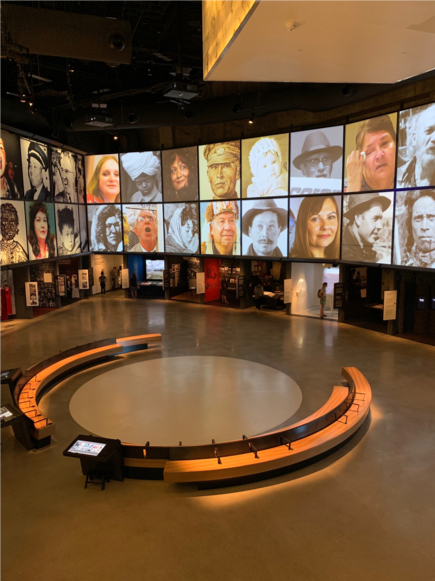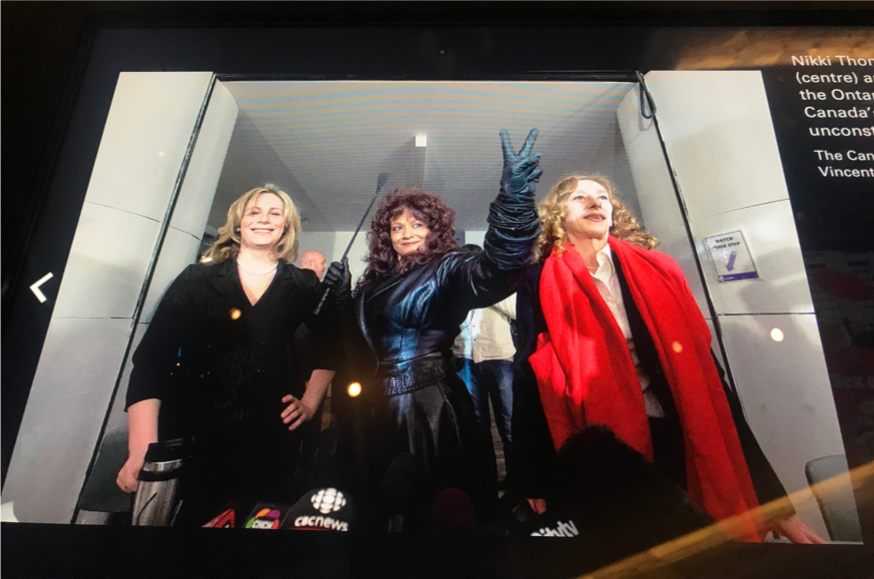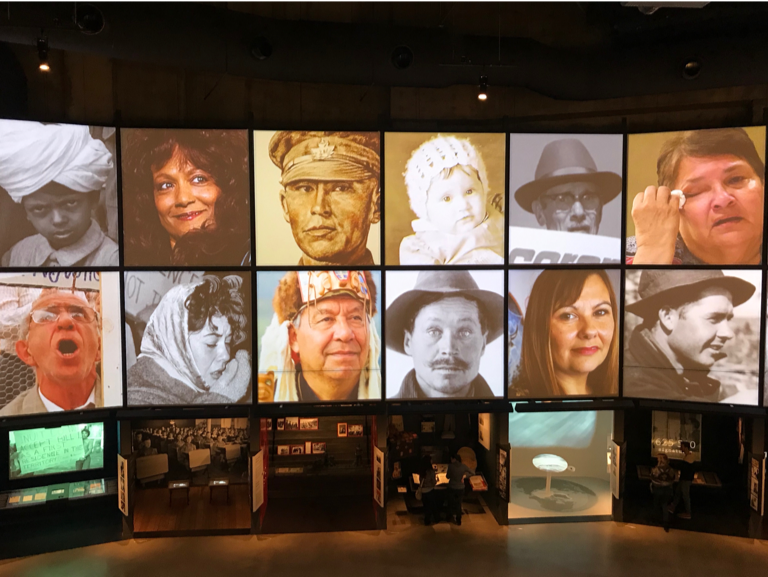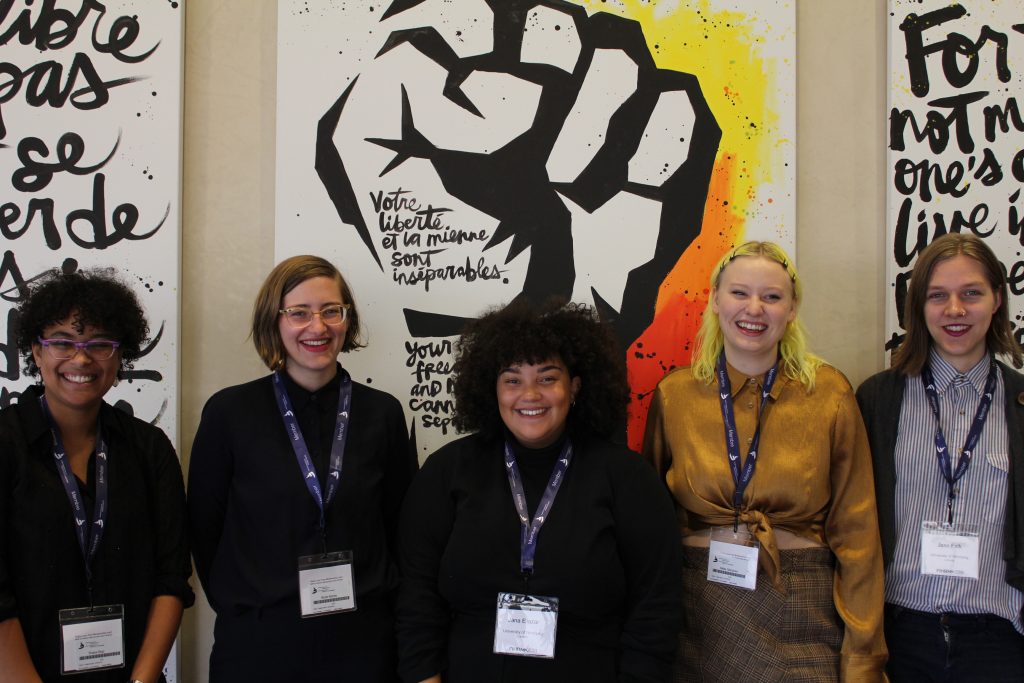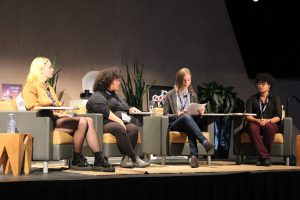By Claire Wright*
I have to admit that before I moved to Winnipeg this fall, I had never heard of the Canadian Museum for Human Rights (CMHR), Canada’s newest national museum. My past research into museums has been focused around early Canadian archaeology, its ties to the Royal Ontario Museum’s collections, and the roles museums have historically played in colonization and the building of empire. As a Research Assistant with the Museum Queeries project, I’ve been particularly intrigued by the notion of the CMHR as an “idea” museum; a shiny new institution with no skeletons in its closet in the most literal sense. In a 2013 interview, then-CEO of the CMHR Stuart Murray explained: “We’re not an artefact museum—we’re more of a digital technology, idea museum.” Where does this place the CMHR within the history of museology? Might new strategies of collection and display queer the museum, or do they merely provide a new image for familiar practices?
What struck me most when visiting the museum was its apparent alignment with the curatorial ideologies of “new museology,” a critique-based approach to museums as public institutions–an alignment which ultimately fails. Although attempting to avoid a top-down enforcement of knowledge and over-reliance on matter-as-truth in the spirit of new museology, the CMHR actually treats its collection of stories, images, and affects much as an “old” museum might its artefacts. Implicitly positioned in contrast to a collection-based historical museum, it seems to be pushing against conceptions of the museum as an elitist and irrelevant institution designed to educate and discipline the public. However, the CMHR does not escape the pitfalls of “old” museology: its collected narratives are subsumed under a framework of national identity, and become objects of cultural capital. This is exemplified in the Indigenous Perspectives gallery, where experiences, affect, and the landscape itself appear as elements of the idea museum’s collection.

(photo credit: Lauren Bosc)
According to Eilean Hooper-Greenhill, the past few decades have seen museology shift towards participation, plurality, and engagement with contemporary social concerns.[1] Leaving behind the authoritative and supposedly neutral voice of traditional institutions, “new” museums might include subjugated voices, strive for curatorial transparency, and pursue active dialogue with their publics. The CMHR attempts conversation through the tone of its exhibits, blog posts, and collaborative displays. Its overarching message of equality extends to many of its didactic panels, which are full of open questions, calls to reflect and develop one’s own opinion, and insights from multiple contributors. The museum positions itself as an institution that holds and curates information, but that does not dictate truth or produce knowledge of or over others. The “About” page on its website, for instance, declares the museum will “welcome [its] visitors as partners on a journey,” and “offers both the inspiration and tools to make a difference in the lives of others.” Rather than curating a collection of objects or artworks, this idea museum houses vast galleries of touch-screens, multi-media kiosks, and countless text and image displays. The museum’s website describes the building as a “striking new landmark,” the product of cutting-edge building techniques and “awe-inspiring” materials.The CMHR is not bogged down by its murky museological past–rather than legitimizing itself through calls to its own history, it consistently declares itsrelevancy through an aura of newness and contemporaneity.
Tucked into the back corner of the museum’s second-floor hall, after a large introductory display about the history of human rights, visitors encounter the Indigenous Perspectives gallery. New museological ideologies are at work in this gallery’s use of aesthetic displays, which are designed to create non-authoritative sentimental attachments with the viewer. In one of the gallery’s digital kiosks, there is mention of the archaeological dig that took place at the museum’s site prior to its construction. We are shown some digital images of the fruits of the endeavour: mostly arrowheads and pottery shards. This small display got me thinking about the CMHR in relation to more traditional, collection-based museums. If these relics are not what the CMHR holds on to, might the museum be collecting something else? Rather than gatheringmaterial evidence of cultural experience, history, or exchange, it purports to focus on collecting personal and community stories, showcasing individual and collective experiences and projects. Instead of relying on the display of material culture to produce knowledge about an Indigenous “Other,” the Indigenous Perspectives gallery uses stories and artistic production to tell an implicitly non-Indigenous audience about Indigenous cultures. The museum relies on art and technology to connect with the viewer, rather than presenting material evidence as the only source of truth, or relying on the aura of historical or scientific authenticity tied to object-based displays. Through videos, quotes, poetry, stories, and art, the museum allows multiple voices to express themselves. However, I wonder if the inclusion and acceptance of multiple knowledges actually guarantees meaningful dialogue, since their expressions are all folded into Canadian identity and a universal humanity. In other words, citizens are encouraged to contribute and produce their own knowledge, but it is subsumed within a story dictated by the institution.

This gallery and its ties to archaeology also purport to establish how the museum relates to the land it’s on, as it introduces a long history of Indigenous presence in the region. A window looks out over The Forks, accompanied by a panel about the area’s history. A bronze cast of a centuries-old footprint—uncovered during the archaeological dig—lends affective weight to the panel, encouraging us to connect with the former inhabitants of the museum site. Material culture, then, is used not to produce scientific knowledge, but to connect the museum and its visitors to The Forks, to Winnipeg, and to Indigenous history. The landscape itself, framed by the window and historicized by the panel, becomes part of the collection, materially grounding the gallery. The viewer is encouraged to participate in the historicity of the land, and relate sentimentally to Indigenous philosophies and experiences.
In a 2011 CBC article about the CMHR dig, archaeologists who worked on the project claim museum officials ignored recommendations for continuing the excavation. While the museum may have neglected to fully excavate the area in order to get construction under way, it does not hesitate to use this material proof of human presence to establish itself as somehow a part of the land’s history. The evidence of Indigenous life beneath its foundation “legitimizes” its claims to the site, as indigeneity becomes a sentimental residue of Canadian, (and more broadly, human) history. Early North American archaeologists did not trust Indigenous communities with their material or immaterial heritage, and laid claim to both culture and territory through collecting. The CMHR literally and figuratively mined the land it sits on for indigeneity, quietly sidestepping any questions of its right to that very land through the ethics of sharing, collaboration, sentimental identification and recognition that pervade its gallery spaces.
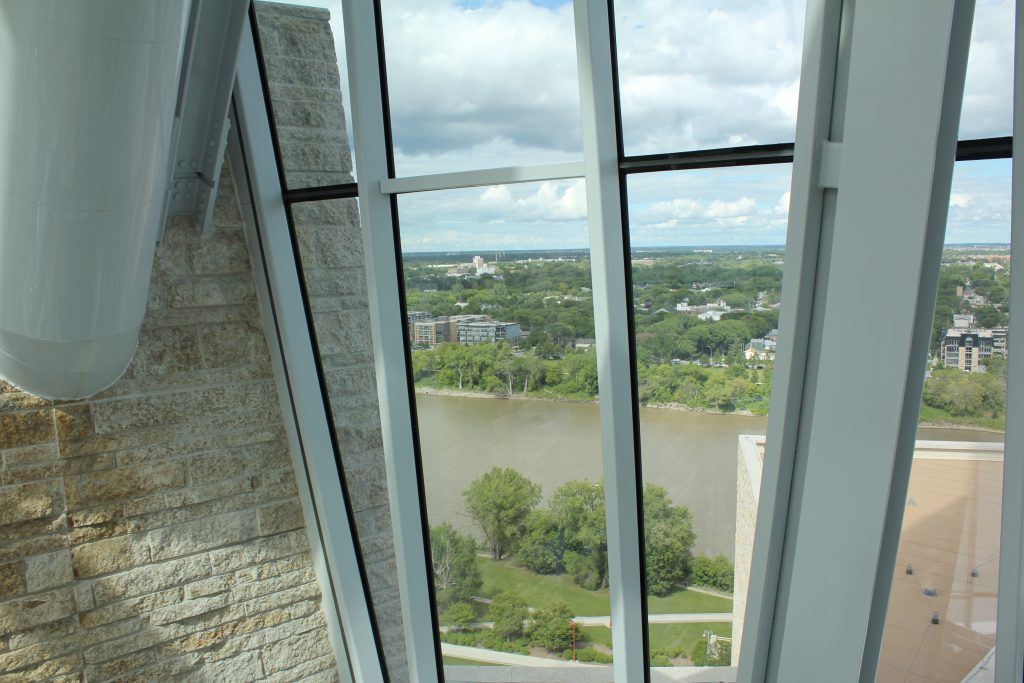
(photo credit: Angela Failler)
The landscape continues to be a prominent feature, and the museum consistently places itself in relation to its geographic position. The CMHR’s architecture not only directs the visitor along a teleological path towards human rights and equality, but intersperses the global with the local and the national with the regional.The viewer is cocooned in expansive but dark galleries, and crisscrossed layers of glowing alabaster. Periodically, however, we catch glimpses of the outside world, stepping into patches of brilliant sunshine streaming through the museum’s glass walls. The museum features several such stops along the journey upwards, allowing visitors to look out upon the city in moments of rest or reflection. The peak of the museum, and the grand conclusion of its pathway, is the Tower of Hope–a monument to peace and victory over adversity. Visitors are offered a bird’s eye view of the city below, tiny and tranquil under the benevolent, optimistic gaze of the tower. The viewer is thus never fully swept away into the narrative worlds of the museum’s galleries- the institution’s space is interspersed with reminders of our position, before finally opening up to this panorama.This use of the local as a situating force provides the opportunity for reflection and seems to disrupt the grand narratives of “old” museology. These reminders of the viewers’ positionality, alongside the artwork and stories included in the CMHR, might spark the production of counter-narratives and critique. The museum’s singular narrative of triumph and hope, however, extends to its framing of the land. It’s worth noting, for instance, that the only part of the city not visible from the Tower of Hope is Winnipeg’s North End—home to much of the city’s Indigenous population, and blocked from view by an elevator shaft.[2]
At times the CMHR focuses on its location, its material specificity and situatedness; at times it gestures to global unity, and international experiences. Overall, it maintains a generalized conception of rights and equality; and a concern with affective, immaterial knowledge. Its exhibits are composed of stories, images, and interactive panels- collections of objectified experience, occasionally punctuated with views of the landscape. “Old” museums have been faulted for presenting artefacts and relics with little to no context, as objects of scientific and historic knowledge about cultures Other to the West. “New” museums, however, are not safe from the pitfalls of traditional museology. At the CMHR, stories are presented without sufficient context or depth, as objects of a sentimental knowledge about humanity in general. It becomes a celebration not of material conquest or ownership, but of the nation’s affective, experiential wealth—where cultural capital is created from distinct experiences, stories of triumph, and the recognition of diverse histories. Similarly, the landscape is framed affectively, and presented as something we all share, with a history we can all experience. This hopeful tone masks a colonial ideology, granting legitimacy to this sparkling monument to Canada’s image as a global human rights leader—a monument that literally sits atop a buried history of Indigenous presence.
[1] Hooper-Greenhill, Eilean. Museums and the Interpretation of Visual Culture. New York: Routledge, 2000. Print. p. 140.
[2] Dean, Amber, and Angela Failler. “‘An Amazing Gift’? Memory Entrepreneurship, Settler Colonialism and the Canadian Museum for Human Rights.” Memory Studies, Apr. 2019, p. 9.
*Claire Wright holds a BFA in printmaking from OCAD U, and has recently completed an MA in Cultural Studies at the University of Winnipeg. She is interested in the role of aesthetics and material culture in affective communication and meaning-making; and with relationships between art, activism, and education.

